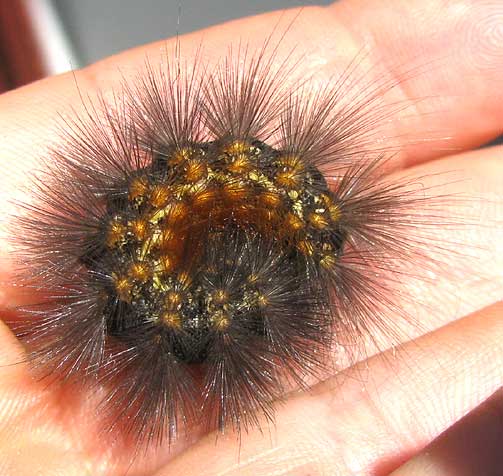Excerpts from Jim Conrad's
Naturalist Newsletter

from the October 21, 2012 Newsletter issued from the valley of the Dry Frio River in northern Uvalde County, southwestern Texas, on the southern border of the Edwards Plateau; elevation ~1750m (~5750 ft); N29.62°, W99.86°; USA
SALT MARSH CATERPILLAR
A very fuzzy caterpillar wiggled fast across the driveway and climbed up a stepladder on which potted plants were arranged. He's shown about to enter one of the pots above.
I wasn't sure he should be on my potted plant so I picked him off, causing him to curl into a defensive ball so that all his soft belly spots were protected by spiky hairs, as shown below:

In eastern North America during the fall similar caterpillars often are noticed crossing roads and generally wandering about. Every kid knows them as Woollyworms or Woollybears. They're caterpillars of the Isabella Tiger Moth, and folklore has it that you can predict how harsh the upcoming winter will be by how dark the Woollyworm is -- the darker the Woollyworm, the colder the coming winter. However, Woolyworms exhibit black and orangish bands while our stepladder caterpillar -- very similar in all other features -- displayed no bands. So off the picture went to volunteer identifier Bea in Ontario, who recognized it immediately, since it also occurs up there.
It's the larva of the Salt Marsh Moth, also known as the Acrea Moth, ESTIGMENE ACREA. The caterpillars are sometimes known as Salt Marsh Caterpillars. Salt Marsh Caterpillars are indeed in the same moth family as Woollyworms, the Arctiidae, but they're in entirely different genera, so they're not as closely related as I'd figured they were.
Salt Marsh Caterpillars, despite their English name, occur in many habitats other than salt marshes, and in places far from salt marshes. They're found all across the US, from southern Canada south through Mexico into Central America. They eat a wide variety of foods, including cabbage, cotton, leaves of walnut and apple trees, tobacco, pea vines, potato plants, corn and clover, and in some places they damage crops, especially the US Southwest. So, I'm glad I removed this one from my potted plant and I hope it found a nice clover someplace to eat on instead.
Salt Marsh Caterpillars defoliate the plants they feed on. Young larvae feed gregariously and "skeletonize" leaves, eating the blades but leaving the midrib and main veins. Older larvae are solitary and eat large holes in leaves. Older larvae may disperse long distances looking for food, sometimes moving in large numbers.